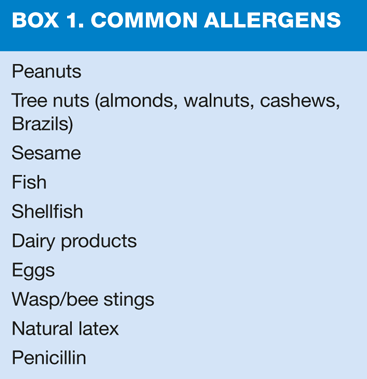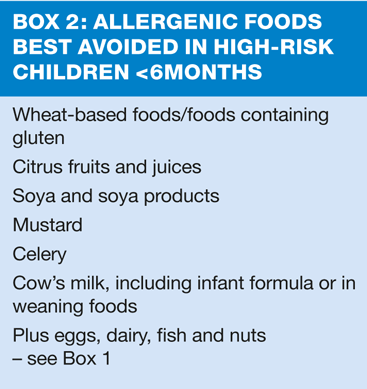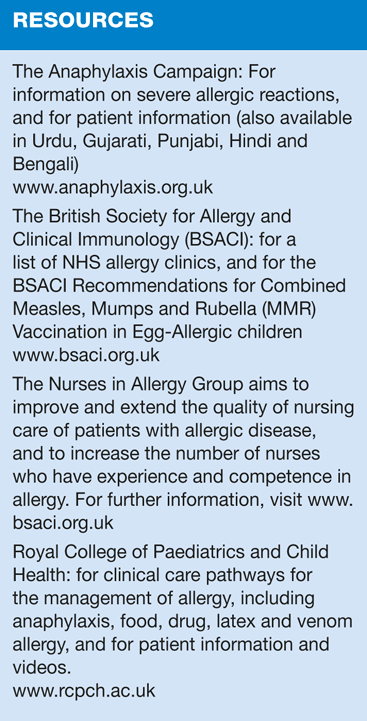
Allergy in children
Mandy Galloway
Mandy Galloway
Medical writer
With so many conditions seen in children having an allergic component, practice nurses are often in the front line of day-to-day allergy management
Allergic disease in children is becoming more common, affecting nearly 40% of children. Allergic disease affects a child's growth, development, educational and psychosocial well-being.1
Allergies range from food and drugs to latex and venom, and allergy plays a critical role in asthma, eczema and rhinitis, with or without conjunctivitis. Allergy affects different children in different ways, and many children suffer from more than one allergy.
Up to 8% of children are affected by a food allergy that results in an immediate reaction, but food allergies may also be more subtle, causing diarrhoea, reflux (regurgitation or vomiting), poor weight gain and eczema, and these can be more difficult to diagnose.1
Children with an allergic tendency or atopy may develop eczema or food allergies in infancy. These conditions may improve over time, but asthma or hayfever may develop in their place.
The majority of patients with allergic disorders can be safely managed within primary care, but it is essential to recognise when children should be referred to specialist services and to be aware of local referral pathways. The British Society for Allergy and Clinical Immunology website offers a search facility to locate NHS allergy clinics providing services for children in your locality.
SYMPTOMS
The allergic response can vary in severity, ranging from a mild urticaria to full-blown anaphylaxis. In many cases, the severity of the reaction may be affected by the dose, or degree of exposure, to the allergen. Response can also be unpredictable. A mild reaction may be followed by a more severe one at a later date.2 In some patients there may be a secondary, or biphasic, reaction, which can occur anywhere between 1 and 72 hours after the initial allergic response.
Symptoms of severe allergy may include some or all of the following:
- Pruritus
- Urticaria
- Angio-oedema, especially of the face or larynx, leading to dyspnoea, dysphonia and dysphagia
- Abdominal cramps and nausea
- Severe asthma
- Collapse and unconsciousness2
FOOD ALLERGY
It is important to remember that only a small proportion of reactions to food are true allergic responses, involving the immune system. Other causes of adverse reactions to foodstuffs include food aversion, a psychological avoidance of certain foods, and food intolerance, an abnormal reaction to food, due to a digestive enzyme deficiency, for example.3
Food allergy is defined as an immune-mediated hypersensitivity reaction to food and may be divided into Immunoglobulin E (IgE) mediated (immediate-onset) reactions and non IgE-mediated (delayed-onset) reactions.4
Food allergy may present in a variety of ways ranging from immediate allergic reactions to more chronic presentations such as eczema or gastrointestinal (GI) symptoms, but many common childhood conditions such as eczema, gastro oesophageal reflux (GOR), diarrhoea, constipation, faltering growth may have an allergic aetiology. Food allergy is more common in children with early onset, moderate or severe eczema.4
Babies with a family history of atopy or allergic disease (at least one affected parent or sibling) are at an increased risk of developing food allergy.4 Exclusive breastfeeding for the first 6 months may be protective, but if this is not possible, an extensively hydrolysed formula may be recommended for high-risk infants. Soya 'milk' formula is not suitable.3
It is usually recommended that high allergenic foods should not be introduced to the diet before the age of 6 months, but there is little evidence that delaying their introduction beyond this age is beneficial to babies at risk of allergy. However, it is recommended that such foodstuffs (Box 2) should be introduced one at a time so that if a reaction occurs, the source can be more easily identified.3
The presence of asthma in a child with peanut allergy, is associated with increased risk of a severe reaction, and good asthma control is essential. Deaths from nut allergy are rare but appear to be more common in children with asthma.5
ATOPIC ECZEMA
Atopic eczema (atopic dermatitis) is a persistent inflammatory itchy skin condition that develops in early childhood in the majority of cases. It is usually an episodic disease, with exacerbations or flares, which may occur as frequently as two or three per month, and remissions. Insevere cases it may be continuous.6
Atopic eczema should be diagnosed when a child has an itchy skin condition plus three or more of the following:
- Visible flexural dermatitis involving the skin creases, such as the bends of the elbows
- Personal history of flexural dermatitis (or dermatitis on the cheeks and/or extensor areas in children aged 18 months or under)
- Personal history of dry skin in the last 12 months
- Personal history of asthma or allergic rhinitis (or history of atopic disease in a first degree relative of children aged under four years)
- Onset of signs and symptoms under the age of two years (this criterion should not be used in children aged under four years).6
Healthcare professionals should also be aware that in Asian, black Caribbean and black African children, atopic eczema may present differently; it can cause skin darkening as opposed to skin reddening (erythema) and can affect the extensor surfaces rather than the flexures. Discoid (circular) or follicular (around hair follicles) patterns of eczema may be more common.6
URTICARIA
Chronic urticaria is another manifestation of allergy: it is relatively common with up to 3% of children being affected. Acute urticaria occurs more commonly, affecting 4.5-15% of UK children.7 Urticaria is characterised by fluctuating wheals and/or angio-oedema. A wheal consists of three typical features:
- A central swelling of variable size, almost invariably surrounded by a reflex erythema
- Associated itching or, sometimes, burning sensation
- A fleeting nature, with the skin returning to its normal appearance, usually within 1-24 hours.7
Chronic urticaria is characterised by continuous symptoms that persist for more than six weeks.7
DIAGNOSTIC TESTS
The most commonly performed diagnostic tests for allergy, usually performed in specialist clinics, involve skin prick tests. Drops of allergen extract are placed on the skin, which is then pricked with a stylus or needle. If the test is positive, a wheal will appear after about 20 minutes. The size of the wheal is measured and recorded.1
Where a skin prick test is not possible - for example, if the patient has had antihistamine treatment within the previous four days - an IgE blood test can be performed to measure the levels of allergic antibody.1
Atopy patch tests are primarily used for the identification of food allergens in severe eczema, and also for the diagnosis of contact allergies. Small metal discs containing the suspected allergen are stuck to the skin for 48 hours, before the skin is examined for signs of a positive reaction.1
The diagnosis of food allergy is often carried out using a food challenge test, which can also be used in children to see if they have outgrown their allergy.1 These tests are administered in hospital under close supervision so that if signs of a reaction appear they can be treated immediately to prevent the development of a more severe reaction. The same technique can also be used to test for allergy to drugs including penicillin or local anaesthetics. Under no circumstances should a child with a suspected peanut allergy be asked to try peanuts at home to see if they are still allergic to them.2
ANAPHYLAXIS
An anaphylactic reaction is caused by the sudden release of chemical substances, including histamine, from cells in the blood and tissues where they are stored. The release is triggered by the reaction between the allergic antibody, immunoglobulin E (IgE), and the substance (allergen). This mechanism is so sensitive that minute quantities of the allergen can cause a reaction. The released chemicals act on blood vessels to cause swelling in the mouth, airways and skin. It is accompanied by a fall in blood pressure. In people with asthma, symptoms are predominantly respiratory.
The Royal College of Paediatrics and Child Health (RCPCH) defines anaphylaxis as a severe, life-threatening, generalised or systemic hypersensitivity reaction which is likely when both of the following criteria are met:
- Sudden onset and rapid progression of symptoms
- Life-threatening airway and/or breathing and/or circulation problems8
Skin and/or mucosal changes (flushing, urticaria, angio-oedema) can also occur but are absent in a significant number of cases.8
Anaphylaxis following vaccination is extremely rare, according to a recent study in the Archives of Disease in Childhood (Practice Nurse, 10 February 2012). It is estimated that the incidence of a true anaphylactic reaction is less than 12 per 100,000 population.9
The study reviewed all reports of suspected anaphylaxis in children under the age of 16 who were vaccinated in the UK or Ireland over a 12-month period. No confirmed cases were linked to the triple MMR vaccine, or other routine infant or pre-school vaccination, despite 5.5 million vaccines being administered over this time.9
Even though this means that many nurses in general practice will never see a true case, it is considered good practice to 'rehearse' the management of anaphylaxis, and whenever vaccines are to be administered, to have resuscitation equipment available.3
The very-rarely encountered child who is known to have had an anaphylactic response to a constituent of a vaccine should not receive that vaccine, but minor allergic reactions to eggs or antibiotics are not relevant. The MMR vaccine does contain trace quantities of egg protein, but it can be given safely even to children who have had an anaphylactic reaction to egg. Influenza and yellow fever vaccinations, on the other hand, are contraindicated in such children.3
TREATMENT
The treatment for a severe allergic reaction is adrenaline (epinephrine). Administered promptly following exposure, adrenaline can reverse features of anaphylaxis by acting on adrenoreceptors to reverse vasodilatation and reduce oedema, dilate airways, increase the force of myocardial contraction, and to suppress further histamine and leukotriene release.2
Injectable adrenaline should be prescribed to anyone who has had all allergic reaction that:
- Was severe (laryngeal oedema, respiratory symptoms or hypotension)
- Was associated with respiratory symptoms even if mild
- Occurred on exposure to a trace amount of allergen
- Occurred in someone who has asthma requiring regular inhaled corticosteroids
Oral antihistamines should also be prescribed, and patients who have asthma should be advised also to continue to use inhaled beta2 agonists.
Other treatment approaches for allergy include desensitisation, which can be suitable for patients who have had allergic reactions to wasp or bee stings, to prevent further severe reactions if they are stung again.
For less severe allergic reactions, treatment aims to moderate histamine response and/or inflammation. A number of oral antihistamines are available, including preparations that are non-sedating. Suitability for use in children varies according to age and from product to product, so prescribers should consult the BNF to identify those which are indicated for the individual child. The anti-inflammatory agent, sodium cromoglicate, is used to alleviate symptoms of confirmed food allergy in children over 2 years.
Topical antihistamines and anti-inflammatory agents, administered as nasal sprays, are used in allergic rhinitis; to reduce the allergic response, a nasal spray containing a corticosteroid should be prescribed.
ALLERGY MANAGEMENT PLANS
A management plan agreed between the specialist allergy clinic and the patient (or parent) has been shown to reduce the risks of severe allergic reactions, with fewer patients experiencing further reactions, and when these do occur, they tend to be less severe. The key parts of an ongoing management plan are how to avoid allergens in the future, and how to recognise the signs of an allergic reaction and when to administer adrenaline.
The child's school also needs to be aware of the child's allergy, their symptoms, how to recognise a reaction, and what to do if symptoms occur.
CONCLUSION
Allergy is common, severe allergic responses less so, and anaphylaxis comparatively rare, but practice nurses should be aware of how to manage anaphylaxis 'just in case'. More frequently, nurses in primary care will encounter children with suspected allergies, or conditions that have an allergic component. The majority of patients who experience allergic disorders can be managed in primary care, but it is essential that nurses know when to refer, and are aware of local referral pathways.
REFERENCES
1. Children's Allergy. Information for healthcare professionals. http://www.guysandstthomas.nhs.uk/services/childrens/paediatricallergy/paediatricallergy.aspx
2. The Anaphylaxis Campaign. Information for healthcare professionals - general practice. http://www.anaphylaxis.org.uk/information/health-professionals/general-practioners.aspx
3. Hall D, Williams J, Elliman D (Eds). The Child Surveillance Handbook 3rd edition. Oxford, Radcliffe; 2009
4. Royal College of Paediatrics and Child Health. Allergy care pathways: Food allergy. Available at: www.rcpch.ac.uk/allergy/foodallergy
5. Macdougall CF, Cant AJ, Colver AF. How dangerous is food allergy in childhood? The incidence of severe and fatal reactions across the UK and Ireland. Arch Dis Child 2002;86:236-9
6. Royal College of Paediatrics and Child Health. Allergy care pathways: Eczema. Available at: www.rcpch.ac.uk/allergy/eczema
7. Royal College of Paediatrics and Child Health. Allergy care pathways: Urticaria. Available at: www.rcpch.ac.uk/allergy/urticaria
8. Royal College of Paediatrics and Child Health. Allergy care pathways: anaphylaxis. Available at: www.rcpch.ac.uk/allergy/anaphylaxis
9. Erlewyn-Lajeunesse M, Hunt LP, Heath PT, et al. Anaphylaxis as an adverse event following immunisation in the Uk and Ireland. Arch Dis Child 2012; doi:10.1136/archdiseasechild-2011-301163
Related articles
View all Articles


